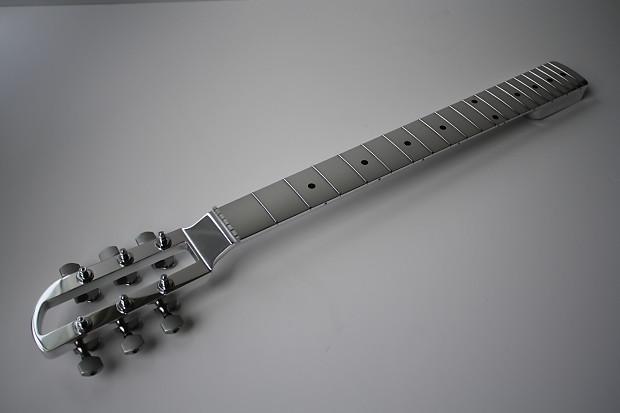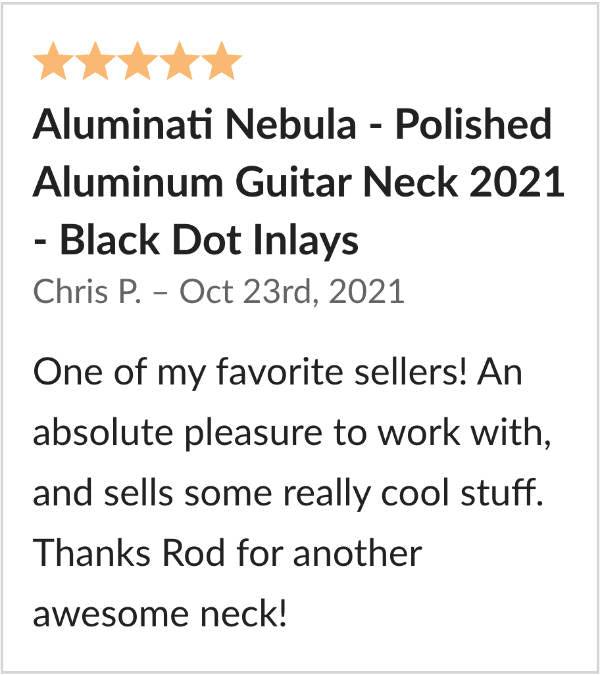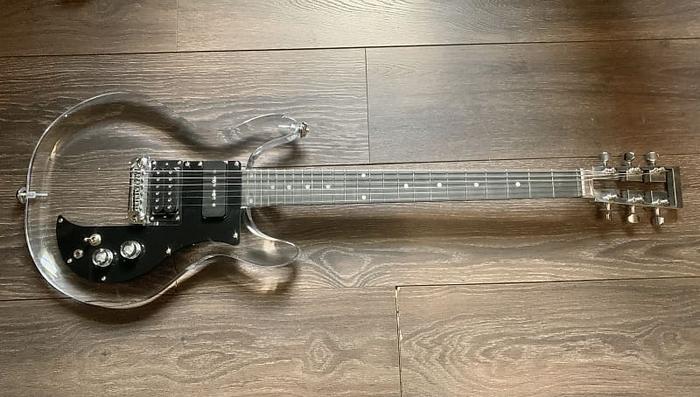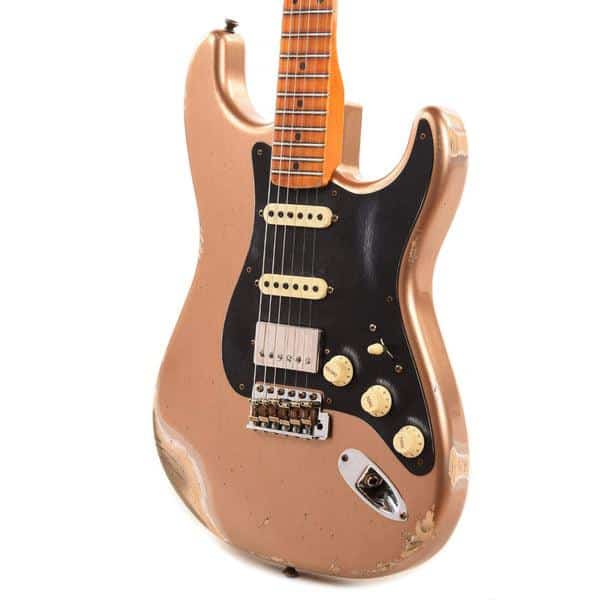I still remember the first time I held an aluminum neck guitar. The cold, sleek neck in my hands felt alien compared to the familiar warmth of wood. As an engineer turned luthier, I’d made a career crafting beautiful wooden necks. But that moment sparked a fascination with the innovative world of aluminum guitar necks that has driven my work ever since.
Everything I knew about traditional guitar design was about to change. Would aluminum necks really prove to be the game-changer some claimed? And could they even come close to challenging the dominance of wood in the world of guitars?
The journey to answer these questions revealed a world of unexpected innovation. I found that aluminum neck guitars weren’t just an interesting quirk; they were a groundbreaking development in the world of guitar design. A secret weapon for those daring to experiment with their sound, and hunt for the perfect tones.
While the complete rundown of my explorations manifests in this article, let’s commence with a bold claim: aluminum neck guitars can dramatically revolutionize the sound, playability, and durability aspects of your music instrument. Now, I can sense the wave of skepticism already rolling in from musicians and luthiers alike. Trust me, I was one of you.
However, throughout this article, I’m about to reveal how aluminum necks are an example of how finding new, innovative approaches can unlock unique capabilities in something as timeless as a guitar. And by the end of our journey, you might just find yourself as captivated by this innovation in guitar necks as I am.
Characteristics of Aluminum Neck Guitars
Sustain and Tone

Transitioning from the general characteristics of aluminum neck guitars, let’s delve deeper into the specifically nuanced areas of sustain and tone. As someone trained to appreciate the fine workings of mechanics and acoustics, these two elements hold a fascinating allure for me.
Sustain in aluminum neck guitars is a treasured aspect. The energy conduction abilities of aluminum allow it to vibrate longer, thus extending note sustain. Its density makes the neck stiffer, reducing the energy loss during string vibration, which further improves sustain. The benefit is especially useful while playing blues or hard rock genres, where longer note duration can significantly enhance the overall performance.
In terms of tone, it’s been my observation that the tonal quality from an aluminum neck guitar is unique and a stark diversion from its wooden counterparts. It isn’t necessarily better or worse, just remarkably different. The aluminum neck tone is characterized by bright, crisp highs with plenty of clarity. The mids and lows, on the other hand, tend to occupy a more pronounced place, creating a balanced but distinct musical personality.
The sustain and tone in each aluminum neck guitar, however, can subtly vary due to factors such as body wood type, pickup configuration, and even the specific alloy of aluminum used. I’ve embraced this variability and relish the unique personality it procures in each guitar.
Taking the fascinating journey through the mechanics of guitar acoustics regarding sustain and tone, we can undoubtedly see how the uniqueness of aluminum as a neck material significantly impacts these aspects. This unique appeal often becomes a significant reason many guitar enthusiasts and professionals opt for aluminum neck guitars. Yet, understanding these isn’t complete until we consider the adaptability and endurance qualities, which we will explore in the next section.
Durability and Adjustability

Transitioning from the resonating aural attributes of an aluminum neck guitar, let’s dive into another pertinent subject: the durability and adjustability of these unique instruments. The aluminum neck significantly contributes to the robust nature of these guitars, offering unique advantages that facilitate my fascination.
Durability is a significant aspect where aluminum neck guitars truly outshine their wooden counterparts. Often referred to as ‘aluminum neck durability’, the strength and resistance to wear and tear are unrivaled, contributing to their extended lifespan. Looking back at the countless performances and travel instances, I’m in awe of how my aluminum neck guitar has weathered through, largely unscathed and without any significant structural damage. Comparatively, guitars with wooden necks can be more susceptible to conditions like humidity and temperature fluctuations, which can lead to warping and other damages over time. The resilience of aluminum provides an unmatched durability that ensures these instruments stand the test of time.
Another critical aspect is the adjustability offered. The aluminum neck allows for a precise and straightforward neck adjustment. The stabilizing qualities of aluminum make these neck adjustments longer-lasting as well, maintaining the string action and intonation to your preferred settings for extended periods. The comfort and ease of customizing it to one’s personal preferences is an aspect that elevates the aluminum neck guitar experience for many players, ensuring it is set up for your unique playing style.
Examining the combination of durability and adjustability brought forth in aluminum neck guitars, their longevity, and the flexibility to customize as per personal preferences offers a delightful ownership experience. Such attributes not only make these guitars a worthy investment but also broaden their appeal across various playing styles and genres.
Now that we’ve delved into these standout characteristics of aluminum neck guitars, we transition into a more comparative scope, taking a closer look at aluminum versus wooden neck guitars. This will provide a broader perspective, drawing on comparative analysis to highlight the reasons behind the growing preference for aluminum necks among guitar enthusiasts.
Comparison: Aluminum vs. Wood Neck Guitars

Peering over the landscape of guitar construction, one cannot help but notice the vast variety of materials used in crafting these exceptional instruments. But a question always seems to hover in the air: which is better in neck construction, aluminum or wood?
Bearing years of experience under my belt as a guitar builder, I have had my hands on both aluminum and wood neck guitars. The journey of working with these two vastly different materials has given me a deep understanding and appreciation for their distinct characteristics. Here, I’ll share my thoughts about the aluminum vs. wood neck debate, informed by my personal experiences and extensive knowledge.
Wooden necks are undeniably the traditional choice. They have a classic feel and warmth, both under your fingers and in the resonance they produce. The variable nature of wood is cherished for its deep, rich tone and lively acoustic response. The type of wood used, from maple to rosewood, significantly impacts the playability and tonal qualities of the guitar, offering a world of options for customization.
Aluminum, on the other hand, is a more unconventional choice which gained its popularity in the 70s and 80s due to its unique appeal. The sleek, modern look of an aluminum neck is breathtaking. With its stainless frets, it’s not just about aesthetics; it changes the feel and performance of the guitar. An aluminum neck offers an incredibly stable and consistent playing platform. It has a resonance or ‘ring’ that imparts certain tonal qualities not found in wood.
With that established, why would one choose an aluminum neck layering over the traditional wood, or vice versa? This is where the comparison really comes alive. Can we draw a definitive line and declare the superior choice between these two, or in the end, will it all come down to personal preference?
Is there a definitive winner in the contest between aluminum and wood neck guitars, or does it all come down to personal preferences and performance styles? l have mulled over this question at length. The answer, I have found, is as complex and nuanced as the instruments themselves.
An aluminum neck with stainless frets lends itself well to a guitarist seeking a bright, punchy tone and increased sustain. It also gives you playability that stays consistent in all weather or temperature conditions, due to aluminum’s natural resistance to expanding or contracting with heat or humidity.
However, wood-necked guitars have their own charm. There is an indescribable magic in the weathered feel of a wooden guitar neck as its grain patterns develop and alter the instrument’s voice over many years. Wood tends to warm up the tone, softening the edges of the sound produced. Additionally, different kinds of wood can be chosen to shape a truly individual tonal palette that’s unique to each player’s style.
So, it seems that in the epic battle of aluminum vs. wood neck guitars, the victor might be almost impossible to declare unilaterally. Instead, the champion depends on the individual musician and the specific characteristics that they favor in their instruments.
Having built guitars with both aluminum and wood necks, the answer to me lies not in one being superior than the other, but rather in celebrating the unique qualities that both materials lend to the resulting sounds and styles. They present captivating avenues for musicians to explore, providing an assortment of auditory landscapes beautifully shaped by personal preferences and performance styles.
In the following chapters, we will delve further into the details and nuances of aluminum neck guitars, deepening our understanding of this remarkable instrument and its place in the world of music.
Popular Brands and Models
Brand-specific Features

Building off our previous exploration into popular brands and models, it’s now time to delve deeper into some fascinating brand-specific features that truly accentuate the distinctive appeal of aluminum neck guitars. Evaluating unique features of instruments has always been my passion and uncovering what sets each brand apart presents a thrilling opportunity for exploration.
One standout feature that caught my attention during this exploration is the hollow-core aluminum neck. Brands such as Travis Bean have flawlessly incorporated this design element, allowing for reduced weight without compromising on the guitar’s sustain or resonance. The hollow-core design cleverly balances the robust aluminum construction with player-friendly ergonomics, a marriage of form and function that’s hard to resist.
Contrastingly, Kramers have embraced a different approach with their neck-through construction. This design facilitates an unimpeded transfer of sound energy through the body, creating an uninterrupted resonance path and thereby, a solid sustain. Coupled with the inherent durability of aluminum, the neck-through construction makes for a resilient masterpiece.
On the other side of this construction divide, we find the bolt-on neck. Exemplified by brands like Wandre, this feature offers modularity and flexibility of setup. The detachable nature of the bolt-on neck allows for easier adjustments and repairs, adding to the long-term value of these guitars.
Moreover, an in-depth look at aluminum neck guitars wouldn’t be complete without mentioning the unique tone provided by Lollar pickups. Found in instruments by Electrical Guitar Company amongst others, these pickups enhance the bright and punchy sounds characteristic of aluminum guitars, ensuring a distinct and satisfying audible experience.
In summary, aluminum neck guitars boast an interesting array of brand-specific features, ranging from hollow-core and neck-through designs to bolt-on necks and bespoke Lollar pickups. It’s this diversity of design and innovation that contributes to the rich tapestry of these remarkable instruments.
Driven by my curiosity and love for exploring, my journey doesn’t stop here. Walking deeper into the woods of intricate craftsmanship, the next illuminating path unveils the adaptation of customization and modding opportunities in the realm of aluminum neck guitars.
Customization and Modding Opportunities

So far, we’ve taken a deep dive into understanding the characteristics of aluminum neck guitars, their renowned sustain and tone, robust durability, and even made some comparisons between aluminum and wooden counterparts. Now, let’s venture in a direction that I’m particularly passionate about, as someone who has spent countless hours experimenting with guitar customization: modification, or ‘modding’ opportunities for these metallic wonders.
Have you ever desired to breathe new life into your beloved guitar through customization? What if aluminum neck modding was the answer? As someone with a significant amount of hands-on experience in guitar modding, I can confidently attest to the creative possibilities lying dormant in your aluminum neck guitar, waiting to be awakened. This isn’t just about replacement guitar necks; this involves reshaping your instrument with a personal touch that aligns with your unique musical style and aspirations.
Custom guitar necks are primarily an aesthetic mod, but they can also drastically impact the fingerboard’s feel, reshape the neck entirely, influence how your hand navigates the fretboard, and ultimately, redefine your playing experience. Aluminum neck modding often involves implementing a custom contour, changing the width or tapering according to personal preferences, or even integrating custom inlays for an extra dash of personality.
I’ve reveled in molding the neck and the body into my artistic vision, and yet, what’s most noteworthy about the journey is the accompanying acoustic learning curve. With every mod, there’s a new rhythm, a distinct resonance birthed, and it’s these subtle transformations which fascinate me to no end.
While exploring guitar modding, you’ll soon discover that it’s not just about the neck or body. The bridges, pickups, tuners, and fret wires contribute to defining your instrument’s uniqueness. Aluminum neck guitars are generally more adaptable to such modifications, absorbing the alterations with grace and morphing sound profiles substantially, more so than their wooden cousins.
And what about that Jane Doe model you’ve been keeping in your attic? Replace its aged, wooden neck with a sleek, new aluminum one and witness it embody a refreshed tonality. Swapping necks isn’t merely about refurbishing, but more often than not, about uncovering latent acoustical treasures that you initially might not have noticed.
I’ve seen guitars stripped to bare bones and reborn with strategic mods and custom parts that revive them as unique, tone-empowered versions of their former selves. It’s not just about the instrumental transformation, but also an opportunity for you to journey into the heart of your guitar, understanding it more intimately through your customization endeavors.
In conclusion, be it fresh replacement guitar necks or comprehensive guitar modding, embracing the scope of customization in aluminum neck guitars is indeed a creative exploration with unrivalled opportunities. It’s an emotive journey with the instrument, an experience that a lot of us musicians yearn for. So, why not take your trusty string companion and embark on this artistic expedition?
Up next we’ll be touching upon the sustainability of aluminum neck guitars, an essential topic that addresses our responsibility towards Mother Nature even as we journey into the world of music. Stay tuned!
Sustainability of Aluminum Neck Guitars

As a fervent advocate for sustainable guitar manufacturing, I have continually sought out innovative solutions for more sustainable practices within the industry. The process isn’t just an environmental mandate, but a way of engineering a guitar to sound and feel its absolute best. Among the various materials that can be molded into an instrument of exquisite resonance, aircraft grade aluminum used in guitar necks, constitutes a cornerstone of my research, and here’s why.
Did you know that your choice of guitar could impact the environment? How sustainable do you reckon an aluminum neck guitar could be? Conspicuously, your decision of embracing an aluminum neck guitar contributes not only to achieving an elevated music aesthetic, but also to nurturing a healthier environment. Let us delve into how this happens.
The manufacture of guitars often demands exploitative extraction of hardwoods like mahogany and rosewood, which contributes to deforestation and challenges the world’s ecological equilibrium. By contrast, aircraft grade aluminum, a key material in creating aluminum neck guitars, is not only easily accessible but also 100% recyclable. This potent characteristic means that, unlike their hardwood counterparts, these guitars can be repurposed at the end of their lifecycle, keeping them out of landfills and nudging us toward a more sustainable and wastefree industry.
Drawing from more than a decade of working with sustainable guitar materials, I’ve found that the adoption of aircraft grade aluminum not only assures longevity but also carries a lightness and durability that outperforms many other materials. Aluminum neck guitars, hence, aren’t only ecologically responsible but also offer added advantages in terms of stability and longevity, ensuring you enjoy playing your beloved instrument for years, even decades to come.
Perhaps the most rewarding part of crafting with aluminum is not only its lifecycle and performance benefits, but its inherent recyclability. It’s humbling, and indeed inspiring, to imagine a time-worn guitar finding new life as an entirely different object, hence contributing to the cyclical economy rather than becoming a one-time-use product. The narrative of recyclable guitars is not merely a tale of eco-friendliness, but a testament to the artistic and functional potential of this remarkable material.
In conclusion, your choice of an aluminum neck guitar won’t just contribute to a unique tone and incredible sustain, but you’ll also become a part of an important movement towards responsible and sustainable creation. As a creative community of musicians and luthiers, I believe it’s not just our responsibility, but our privilege, to play our part in conserving our planet and its resources while exploring the fascinating frontier of innovative guitar design.
The road to sustainable guitar manufacturing is long and quite complex. But through conscious choices, like opting for an aluminum neck guitar, each one of us can contribute in a meaningful way. This journey isn’t just about creating music, it’s about harmonizing our advancements with nature rather than moving against it, embracing a future of sustainable and innovative instrument craftsmanship.
FAQs
What is an Aluminum Neck Guitar?
Why Choose an Aluminum Neck Guitar?
How does Aluminum Neck Guitar Sound Like?
Are there any notable artists who use Aluminum Neck Guitars?
Conclusion
In this journey of distinction and discovery, we have dissected the fascinating world of aluminum neck guitars in great depth. We’ve stemmed our understanding from their unique characteristics, exploring the nuances of sustain and tone, durability, and adjustability that these instruments provide. We have peered into the great debate, a comparison between aluminum and traditional wood neck guitars, unmasking the truth in their differences.
Are you ready to discover a totally new and fascinating world of guitars with aluminum necks? Are you ready to explore how innovation in materials could revolutionize how we perceive and play this beloved instrument?
We’ve explored popular brands and models with brand-specific features that distinguish them and have investigated the plethora of customization and modding opportunities these instruments offer. Our quest further led us to understand the sustainability dimension, a testament to the conscious choices behind these unique guitars.
Being a string instrument enthusiast, I consider each exploration an opportunity for growth and learning. Through this discussion on aluminum neck guitars, I hope I’ve shared some insights into my journey and piqued your interest in these remarkable instruments. With each nuance, each trait we’ve uncovered, we have seen how these guitars stand as an ever-evolving testament to innovation in construction materials and technology.
In this ever-changing world of music and instruments, aluminum neck guitars undoubtedly present a compelling argument for any guitarist seeking durability, uniqueness, or a different tonal palate. A whole new world of opportunities awaits for those who dare to venture into the unconventional, breaking free from traditional preferences.
We conclude this deep dive with an enriched understanding and appreciation for the unique blend of science, artistry, and sustainability that reflect in these aluminum wonders. Not a mere alternative to wooden guitars, they stand as a bold statement of innovation and evolution, with a commitment to sustainability. So here’s to embracing change, to unending quests for knowledge, and to continuous explorations in the boundless universe of guitars.